Metallogenic Prediction of the Zaozigou Gold Deposit Using 3D Geological and Geochemical Modeling
Abstract
:1. Introduction
2. Geological Setting
2.1. Regional Geological Background

2.2. Mineral Deposit Features
3. Methods
3.1. Convolutional Neural Network
3.2. The 3D-CNN Model Architecture
4. Dataset and 3D Modeling
4.1. Dataset
4.2. The 3D Geological Modeling
4.3. The 3D Geochemical Modeling
4.3.1. Descriptive Statistical Analysis
4.3.2. Defining the Modeling Range of 3D Data Volume
4.3.3. Spatial Interpolation Method of Primary Geochemical Halo Data
4.3.4. The 3D Geochemical Data Volume Model and Element Spatial Distribution Patterns
5. Results and Discussion
5.1. Geological Geochemical Prospecting Model
5.2. Convolutional-Neural-Network-Based Ore Deposit Prediction
6. Conclusions
Author Contributions
Funding
Data Availability Statement
Acknowledgments
Conflicts of Interest
References
- Houlding, S.W. 3D Geoscience Modeling: Computer Techniques for Geological Characterization; Springer: London, UK, 1994. [Google Scholar]
- Hou, W.S.; Wu, X.C.; Liu, X.G.; Chen, G.N. A complex fault modeling method based on geological plane map. Rock Soil Mech. 2007, 28, 169–172, (In Chinese with English Abstract). [Google Scholar]
- Guo, J.T.; Wu, L.X.; Zhou, W.H. Automatic ore body implicit 3D modeling based on radial basis function surface. J. China Coal Soc. 2016, 41, 2130–2135, (In Chinese with English Abstract). [Google Scholar]
- Mao, X.C.; Zhang, M.M.; Deng, H.; Zou, Y.H.; Chen, J. 3D Visualization Prediction Method for Concealed Ore Bodies in the Deep Mining Area. J. Geol. 2016, 40, 363–371, (In Chinese with English Abstract). [Google Scholar]
- Xiao, K.Y.; Li, N.; Alok, P.; Holden, E.J.; Leon, B. GIS-based 3D prospectivity mapping: A case study of Jiama copper-polymetallic deposit in Tibet, China. Ore Geol. Rev. 2015, 71, 611–632. [Google Scholar] [CrossRef]
- Li, N.; Xiao, K.Y.; Yin, J.N.; Fan, J.F.; Wang, K. A Method of 3D Buffer Analysis of Boundary Representation. J. Comput.-Aided Des. Comput. Graph. 2015, 27, 1625–1636. [Google Scholar]
- Nielsen, S.H.H.; Partigton, G.A.; Franey, D.; Dwight, T. 3D mineral potential modelling of gold distribution at the Tampia gold deposit. Ore Geol. Rev. 2019, 109, 276–289. [Google Scholar] [CrossRef]
- Farahbakhsh, E.; Hezarkhani, A.; Eslamkish, T.; Bahroudi, A.; Chandra, R. Three-dimensional weights of evidence modelling of a deep-seated porphyry Cu deposit. Geochem. Explor. Environ. Anal. 2020, 20, 480–495. [Google Scholar] [CrossRef]
- Mao, X.C.; Deng, H.; Chen, J. Research Progress on Three-Dimensional Analysis and Modeling Prediction of Deep Metallogenic Structure. In Proceedings of the Annual Meeting of Chinese Geoscience Union, Beijing, China, 21 October 2018. [Google Scholar]
- Mao, X.C.; Wang, Q.; Chen, J.; Deng, H.; Liu, Z.K.; Wang, J.L.; Chen, J.P.; Xiao, K.Y. Three-dimensional Modeling of Deep Metallogenic Structure in Northwestern Jiaodong Peninsula and Its Gold Prospecting Significance. Acta Geol. Sin. 2020, 41, 166–178. [Google Scholar]
- Agterberg, F.P. Automatic contouring of geological maps to detect target areas for mineral exploration. J. Int. Assoc. Math. Geol. 1974, 6, 373–375. [Google Scholar] [CrossRef]
- Zhao, P.D.; Meng, X.G. Geological Anomaly and Mineral Prediction. Earth Sci. 1993, 18, 682–684, (In Chinese with English Abstract). [Google Scholar]
- Cheng, Q.M. Singularity-Generalized Self-Similarity-Fractal Spectrum (3S) Models. Earth Sci. 2006, 31, 337–348, (In Chinese with English Abstract). [Google Scholar]
- Chen, J.P.; Lv, P.; Wu, W.; Zhao, J.; Hu, Q. A 3D method for predicting blind orebodies, based on a 3D visualization model and its application. Earth Sci. Front. 2007, 14, 54–62, (In Chinese with English Abstract). [Google Scholar] [CrossRef]
- Song, M.; Li, S.; Zheng, J.; Wang, B.; Fan, J.; Yang, Z.; Wen, G.; Liu, H.; He, C.; Zhang, L.; et al. A 3D Predictive Method for Deep-Seated Gold Deposits in the Northwest Jiaodong Peninsula and Predicted Results of Main Metallogenic Belts. Minerals 2022, 12, 935. [Google Scholar] [CrossRef]
- Xiao, K.; Xiang, J.; Fan, M.; Xu, Y. 3D mineral prospectivity mapping based on deep metallogenic prediction theory: A case study of the Lala Copper Mine, Sichuan, China. J. Earth Sci. 2021, 32, 348–357. [Google Scholar] [CrossRef]
- Mao, X.C.; Zhou, Y.H.; Chen, J.; Lai, J.Q.; Peng, S.L.; Shao, Y.J.; Shu, Z.M.; Lv, J.W.; Lv, Z.Y. Three-Dimension Visual Prediction Of Concealed Ore Bodies in the Deep and Marginal Parts of crisis Mines: A case Study of the Fenghuangshan Ore Field in Tongling, Anhui, China. Geol. Bull. China 2010, 29, 401–413, (In Chinese with English Abstract). [Google Scholar]
- Liu, Y.; Zhou, K.F. Gold Anomaly Identification and Its Uncertainty Analysis in the West Junggar Belt, Xinjiang. Earth Sci. 2018, 43, 3186–3199, (In Chinese with English Abstract). [Google Scholar]
- Zhang, Q.; Chen, J.; Xu, H.; Jia, Y.; Chen, X.; Jia, Z.; Liu, H. Three-dimensional mineral prospectivity mapping by XGBoost modeling: A case study of the Lannigou gold deposit, China. Nat. Resour. Res. 2022, 31, 1135–1156. [Google Scholar] [CrossRef]
- Mao, X.C.; Ren, J.; Liu, Z.K.; Chen, J.; Tang, L.; Deng, H.; Bayless, R.C.; Yang, B.; Wang, M.J.; Liu, C.M. Three-dimensional prospectivity modeling of the Jiaojia-type gold deposit, Jiaodong Peninsula, Eastern China: A case study of the Dayingezhuang deposit. J. Geochem. Explor. 2019, 203, 27–44, (In Chinese with English Abstract). [Google Scholar] [CrossRef]
- Yousefi, M.; Kreuzer, O.P.; Nykanen, V.; Hronsky, J.M.A. Exploration information systems-A proposal for the future use of GIS in mineral exploration targeting. Ore Geol. Rev. 2019, 111, 103005. [Google Scholar] [CrossRef]
- Liu, G.; Wu, C.L.; He, Z.W.; Wong, Z.P.; Zhu, Q.; Zhang, Y.T.; Li, X.M. Design and Application of 3D Spatial Database Model for Integrated Management of Aboveground and Underground Features. Earth. Sci. 2011, 36, 367–374, (In Chinese with English Abstract). [Google Scholar]
- Sun, L.; Xiao, K.Y.; Tang, J.X.; Zou, W.; Li, N.; Sun, Y. 3D Geologic Modeling of Jiama Cu Deposit Based on Minexplorer System. J. Chengdu Univ. Technol. Sci. Technol. Ed. 2011, 38, 291–297, (In Chinese with English Abstract). [Google Scholar]
- Xiao, K.Y.; Li, N.; Sun, L.; Zou, W.; Li, Y. Large scale 3D mineral prediction methods and channels based on 3D information technology. J. Geol. 2012, 36, 229–236, (In Chinese with English Abstract). [Google Scholar]
- Chen, J.P.; Yu, M.; Yu, P.P.; Shang, B.C.; Zheng, X.; Wang, L.M. Method and Practice of 3D Geological Modeling at Key Metallogenic Belt with Large and Medium Scale. Acta Geol. Sin. 2014, 88, 1187–1195, (In Chinese with English Abstract). [Google Scholar]
- Wang, K.; Xiao, K.Y.; Yan, Y.Y. Application of 3 D modeling technology in Lead-zinc prospecting in Huayuan, Hunan Province. J. Geol. 2014, 38, 441–444, (In Chinese with English Abstract). [Google Scholar]
- Zhang, M.M.; Li, X.H.; Yuan, F.; Hu, X.Y.; Wang, X.H. Comparative Study Between Three-Dimensional Straya Modeling and Surface model Interpolation. Anhui Geol. 2015, 25, 182–186, (In Chinese with English Abstract). [Google Scholar]
- Gao, L.; Liu, Q.Y.; Xv, S.T.; Yang, T.; Yv, P.P.; Zhou, Y.Z. Three-dimensional geological modeling of deposits and reserve estimation: A case study of the Jingkou ore block of the Fengcun Pb-Zn deposit. Geol. Explor. 2016, 52, 956–965, (In Chinese with English Abstract). [Google Scholar]
- Carranza, E.J.M.; Sadeghi, M. Primary geochemical characteristics of mineral deposits—Implications for exploration. Ore Geol. Rev. 2012, 45, 1–4. [Google Scholar] [CrossRef]
- Safronov, N.I. Dispersion haloes of ore deposits and their use in exploration. Probl. Sov. Geol. 1936, 4, 41–53. [Google Scholar]
- Distler, V.V.; Yudovskaya, M.A.; Mitrofanov, G.L.; Prokof’Ev, V.Y.; Lishnevskii, E.N. Geology, composition, and genesis of the Sukhoi Log noble metals deposit, Russia. Ore Geol. Rev. 2004, 24, 7–44. [Google Scholar] [CrossRef]
- Gundobin, G.M. Peculiarities in the zoning of primary halos. J. Geochem. Explor. 1984, 21, 193–200. [Google Scholar] [CrossRef]
- Ziaii, M.; Carranza, E.J.M.; Ziaei, M. Application of geochemical zonality coefficients in mineral prospectivity mapping. Comput. Geosci. 2011, 37, 1935–1945. [Google Scholar] [CrossRef]
- Goodell, P.C.; Petersen, U. Julcani mining district, Peru: A study of metal ratios. Econ. Geol. 1974, 69, 347–361. [Google Scholar] [CrossRef]
- Jones, B.K. Application of metal zoning to gold exploration in porphyry copper systems. J. Geochem. Explor. 1992, 43, 127–155. [Google Scholar] [CrossRef]
- Pirajno, F.; Smithies, R.H. The FeO/(FeO+MgO) ratio of tourmaline: A useful indicator of spatial variations in granite-related hydrothermal mineral deposits. J. Geochem. Explor. 1992, 42, 371–381. [Google Scholar] [CrossRef]
- Kreĭn, M.G.; Melik-Adamjan, F.È. An integrated lithogeochemical approach to detecting and interpreting cryptic alteration around the Elura Zn-Pb-Ag deposit, New South Wales, Australia. Geochem. Explor. Environ. Anal. 2011, 11, 233–246. [Google Scholar]
- Pearce, T.H. A contribution to the theory of variation diagrams. Contrib. Mineral. Petrol. 1968, 19, 142–157. [Google Scholar] [CrossRef]
- Stanley, C.R.; Madeisky, H.E. Lithogeochemical exploration for hydrothermal ore deposits using molar element ratio analysis. In Alteration and Alteration Processes Associated with Oreforming Systems. Geological Association of Canada, Short Course Handbook; Lentz, D.R., Ed.; Geological Association of Canada: Labrador, NL, Canada, 1994; Volume 11, pp. 193–211. [Google Scholar]
- Urqueta, E.; Kyser, T.K.; Clark, A.H.; Stanley, C.R.; Oates, C.J. Lithogeochemistry of the Collahuasi porphyry Cu-Mo and epithermal Cu-Ag (−Au) cluster, northern Chile: Pearce element ratio vectors to ore. Geochem. Explor. Environ. Anal. 2009, 9, 9–17. [Google Scholar] [CrossRef]
- Barrie, C.T. Petrochemistry of shoshonitic rocks associated with porphyry copper-gold deposits of central Quesnellia, British Columbia, Canada. J. Geochem. Explor. 1993, 48, 225–258. [Google Scholar] [CrossRef]
- Date, J.; Watanabe, T.; Saeki, Y. Zonal alteration around the Fukazawa kuroko deposits, Akita prefecture, northern Japan. Econ. Geol. 1983, 5, 365–386. [Google Scholar]
- Ishikawa, Y.; Sawaguchi, T.; Iwaya, S.; Horiuchi, M. Delineation of prospecting targets for Kuroko deposits based on modes of volcanism of underlying dacite and alteration haloes. Min. Geol. 1976, 26, 105–117. [Google Scholar]
- Kishida, A.; Kerrich, R. Hydrothermal alteration zoning and gold concentration at the Kerr–Addison Archean lode gold deposit, Kirkland Lake, Ontario. Econ. Geol. 1987, 82, 649–690. [Google Scholar] [CrossRef]
- Large, R.R.; Mcgoldrick, P.J. Lithogeochemical halos and geochemical vectors to stratiform sediment hosted Zn–Pb–Ag deposits, 1. Lady Loretta Deposit, Queensland. J. Geochem. Explor. 2000, 68, 105–126. [Google Scholar] [CrossRef]
- Large, R.R.; McPhie, J.; Gemmell, J.B.; Herrmann, W.; Davidson, G.J. The spectrum of ore deposit types, volcanic environments, alteration halos, and related exploration vectors in submarine volcanic successions: Some examples from Australia. Econ. Geol. 2001, 96, 913–938. [Google Scholar] [CrossRef]
- Piché, M.; Jébrak, M. Normative minerals and alteration indices developed for mineral exploration. J. Geochem. Explor. 2004, 82, 59–77. [Google Scholar] [CrossRef]
- Prendergast, K. Application of lithogeochemistry to gold exploration in the St Ives Goldfield, Western Australia. Geochem. Explor. Environ. Anal. 2007, 7, 99–108. [Google Scholar] [CrossRef]
- Wang, L.; Percival, J.; Hedenquist, J.W.; Hattori, K.; Qin, K.Z. Alteration mineralogy of the Zhengguang Au-Zn deposit, Northeast China: Interpretation of shortwave infrared analyses during mineral exploration and assessment. Econ. Geol. 2021, 116, 389–406. [Google Scholar] [CrossRef]
- Xie, X.J.; Chen, H.C. The role of the native halo method in the geological survey and exploration. Acta Geol. Sin. 1961, 41, 273–284. (In Chinese) [Google Scholar]
- Shao, Y. Several problems with the native halo approach. Geol. Explor. 1964, 03, 21–24. (In Chinese) [Google Scholar]
- Beus, A.A.; Grigorian, S.V. Geochemical Exploration Methods for Mineral Deposits; Applied Publishing Ltd.: Wilmette, IL, USA, 1977. [Google Scholar]
- Li, H. An I deal Pattern of Primary Superimposed Halo of Hydrothermal Gold Deposits. Geol. Explor. 1993, 03, 46–51, (In Chinese with English Abstract). [Google Scholar]
- Qing, C.S.; Peng, X.H.; Xu, B.; Yang, H.; Zhang, J.S.; Hu, Y.; Zhong, Y.L.; Mu, X.H.; Wang, T. Research progress of native halo prospecting method. Acta Miner. Sin. 2011, 31, 828–829. (In Chinese) [Google Scholar]
- Li, H.; Yu, B.; Wei, J.; Li, Y.C.; Wang, J.; Wei, Z.X.; Zhang, H.R.; Ren, L.L.; Wang, X.; Sun, F.Z.; et al. A new practical ideal model of structural superimposed halos for prediction of deep blind hydrothermal deposits and its significance. Geol. Explor. 2020, 56, 889–897, (In Chinese with English Abstract). [Google Scholar]
- Ran, X.; Xue, L.; Zhang, Y.; Liu, Z.; Sang, X.; He, J. Rock Classification from Field Image Patches Analyzed Using a Deep Convolutional Neural Network. Mathematics 2019, 7, 755. [Google Scholar] [CrossRef]
- Sang, X.; Xue, L.; Ran, X.; Li, X.; Liu, J.; Liu, Z. Intelligent High-Resolution Geological Mapping Based on SLIC-CNN. ISPRS Int. J. Geo-Inf. 2020, 9, 99. [Google Scholar] [CrossRef]
- Guo, J.; Li, Y.; Jessell, M.W.; Giraud, J.; Li, C.; Wu, L.; Li, F.; Liu, S. 3D geological structure inversion from Noddy-generated magnetic data using deep learning methods. Comput. Geosci. 2021, 149, 104701. [Google Scholar] [CrossRef]
- Li, T.; Zuo, R.; Xiong, Y.; Peng, Y. Random-drop data augmentation of deep convolutional neural network for mineral prospectivity mapping. Nat. Resour. Res. 2021, 30, 27–38. [Google Scholar] [CrossRef]
- Sun, T.; Li, H.; Wu, K.; Chen, F.; Zhu, Z.; Hu, Z. Data-driven predictive modelling of mineral prospectivity using machine learning and deep learning methods: A case study from southern Jiangxi Province, China. Minerals 2020, 10, 102. [Google Scholar] [CrossRef]
- Li, S.; Chen, J.; Liu, C.; Wang, Y. Mineral prospectivity prediction via convolutional neural networks based on geological big data. J. Earth Sci. 2021, 32, 327–347. [Google Scholar] [CrossRef]
- Zhang, S.; Carranza, E.J.; Wei, H.; Xiao, K.; Yang, F.; Xiang, J.; Zhang, S.; Xu, Y. Data-driven mineral prospectivity mapping by joint application of unsupervised convolutional auto-encoder network and supervised convolutional neural network. Nat. Resour. Res. 2021, 30, 1011–1031. [Google Scholar] [CrossRef]
- Feng, Y.M.; Cao, X.Z.; Zhang, E.P.; Hu, Y.X.; Pan, X.P.; Yang, J.L.; Jia, Q.Z.; Li, W.M. Tectonic Evolution Framework and Nature of The West Qinling Orogenic Belt. Northwest. Geol. 2003, 36, 1–10, (In Chinese with English Abstract). [Google Scholar]
- Wei, L.X. Tectonic Evolution and Mineralization of Zaozigou Gold Deposit, Gansu Province. Master’s Thesis, China University of Geosciences, Beijing, China, 2015. (In Chinese with English Abstract). [Google Scholar]
- Zeng, J.J.; Li, K.N.; Yan, K.; Wei, L.L.; Huo, X.D.; Zhang, J.P. Tectonic Setting and Provenance characteristics of the Lower Triassic Jiangligou Formation in West Qinling—Constraints from Geochemistry of Clastic Rock and zircon U-Pb Geochronology of Detrital Zircon. Geol. Rev. 2021, 67, 1–15, (In Chinese with English Abstract). [Google Scholar]
- Li, Z.B.; Liu, Z.Y.; Li, R. Geochemical Characteristics and metallogenic Potential Analysis of Daheba Formation in Ta-Ga Area of Gansu Province. Contrib. Geol. Miner. Resour. Res. 2021, 36, 187–194, (In Chinese with English Abstract). [Google Scholar]
- Li, K.N. Geochemical prospecting perspective of Wengcheng area, Guangdong province. Geol. Miner. Resour. 2014, 30, 138–145. [Google Scholar]
- Chen, Y.; Wang, K.J. Geological Features and Ore Prospecting Indicators of Sishangou Silver Deposit. Gansu. Metal. 2015, 37, 108–111, (In Chinese with English Abstract). [Google Scholar]
- Di, P.F. Geochemistry and Ore-Forming Mechanism on Zaozigou Gold Deposit in Xiahe-Hezuo, West Qinling, China. Doctor’s Thesis, Lanzhou University, Lanzhou, China, 2018. (In Chinese with English Abstract). [Google Scholar]
- Tang, L.; Lin, C.G.; Cheng, Z.Z.; Jia, R.Y.; Li, H.R.; Li, K.N. 3D Characteristics of Primary Halo and Deep Prospecting Prediction in The Zaozigou Gold Deposit, Hezuo City, Gansu Province. Geol. Bull. China 2020, 39, 1173–1181, (In Chinese with English Abstract). [Google Scholar]
- Chen, G.Z.; Wang, J.L.; Liang, Z.L.; Li, P.B.; Ma, H.S.; Zhang, Y.N. Analysis of Geological Structures in Zaozigou Gold Deposit of Gansu Province. Gansu Geol. 2013, 22, 50–57, (In Chinese with English Abstract). [Google Scholar]
- Chen, G.Z.; Liang, M.L.; Wang, J.L.; Zhang, Y.N.; Li, P.B. Characteristics and Deep Prediction of Primary Superimposed Halos in The Zaozigou Gold Deposit of Hezuo, Gansu Province. Geophys. Geochem. Explor. 2014, 38, 268–277, (In Chinese with English Abstract). [Google Scholar]
- Jin, D.G.; Liu, B.C.; Chen, Y.Y.; Liang, Z.L. Spatial Distribution of Gold Bodies in Zaozigou Mine of Gansu Province. Gansu Geol. 2015, 24, 25–30+41, (In Chinese with English Abstract). [Google Scholar]
- Zhu, F.; Wang, G.W. Study on Grade Model of Gansu Zaozigou Gold Mine Based on Geological Statistics. Acta Mineral. Sin. 2015, 35, 1065–1066. (In Chinese) [Google Scholar]
- Chen, G.Z.; Li, L.N.; Zhang, Y.N.; Ma, H.S.; Liang, Z.L.; Wu, X.M. Characteristics of fluid inclusions and deposit formation in Zaozigou gold mine. J. Jilin Univ. (Earth Sci. Ed.) 2015, 45, 1–2. (In Chinese) [Google Scholar]
- Liu, Y.; Liu, Y.H.; Dong, F.C.; Li, Z.H.; Yv, J.K. Accurate Determination and geological significance of Zaozigou gold deposit in Gansu province. Adv. Earth Sci. 2012, 33, 10–15. [Google Scholar]
- Li, W.; Chen, J.P.; Jia, Y.L.; Zhou, G.Y.; Mao, X.C.; Xiao, K.Y. Three-dimensional Modeling and Comprehensive Metallogenic Prediction of the Zaozigou Gold Deposit, Gansu Province. Area. J. Geol. 2020, 41, 144–156, (In Chinese with English Abstract). [Google Scholar]
- LeCun, Y.; Bengio, Y. Convolutional networks for images, speech, and time series. In The Handbook of Brain Theory and Neural Network; Arbib, M.A., Ed.; MIT Press: Cambridge, MA, USA, 1995; p. 3361. [Google Scholar]
- Zeiler, M.D.; Fergus, R. Visualizing and understanding convolutional networks. In Proceedings of the Computer Vision–ECCV 2014: 13th European Conference, Zurich, Switzerland, 6–12 September 2014; Proceedings, Part I 13. Springer International Publishing: Berlin/Heidelberg, Germany, 2014; pp. 818–833. [Google Scholar]
- Nair, V.; Hinton, G.E. Rectified linear units improve restricted boltzmann machines. In Proceedings of the 27th International Conference on Machine Learning (ICML-10), Haifa, Israel, 21–24 June 2010; pp. 807–814. [Google Scholar]
- Sermanet, P.; Eigen, D.; Zhang, X.; Mathieu, M.; Fergus, R.; LeCun, Y. Overfeat: Integrated recognition, localization and detection using convolutional networks. arXiv 2013, arXiv:1312.6229. [Google Scholar]
- Boureau, Y.L.; Ponce, J.; LeCun, Y. A theoretical analysis of feature pooling in visual recognition. In Proceedings of the 27th International Conference on Machine Learning (ICML-10), Haifa, Israel, 21–24 June 2010; pp. 111–118. [Google Scholar]
- Simonyan, K.; Zisserman, A. Very deep convolutional networks for large-scale image recognition. arXiv 2014, arXiv:1409.1556. [Google Scholar]
- Lecun, Y.; Bottou, L.; Bengio, Y.; Haffner, P. Gradient-based learning applied to document recognition. Proc. IEEE 1998, 86, 2278–2324. [Google Scholar] [CrossRef]
- Maturana, D.; Scherer, S. Voxnet: A 3d convolutional neural network for real-time object recognition. In Proceedings of the 2015 IEEE/RSJ International Conference on Intelligent Robots and Systems (IROS), Hamburg, Germany, 28 September–3 October 2015; IEEE: Piscataway, NJ, USA, 2015; pp. 922–928. [Google Scholar]
- Abdoli, S.; Cardinal, P.; Koerich, A.L. End-to-end environmental sound classification using a 1D convolutional neural network. Expert Syst. Appl. 2019, 136, 252–263. [Google Scholar] [CrossRef]
- Ieracitano, C.; Mammone, N.; Bramanti, A.; Hussain, A.; Morabito, F.C. A convolutional neural network approach for classification of dementia stages based on 2D-spectral representation of EEG recordings. Neurocomputing 2019, 323, 96–107. [Google Scholar] [CrossRef]
- Li, X.; Xue, C.; Chen, Y.; Yuan, F.; Li, Y.; Zheng, C.; Zhang, M.; Ge, C.; Guo, D.; Lan, X.; et al. 3D Convolutional Neural Network-based 3D mineral prospectivity modeling for targeting concealed mineralization within Chating area, middle-lower Yangtze River metallogenic Belt, China. Ore Geol. Rev. 2023, 157, 105444. [Google Scholar] [CrossRef]
- Jia, L.J. Research on 3D Geological Modeling Interpolation Algorithm Based on Drilling Data. Master’s Thesis, China University of Geosciences, Beijing, China, 2018. (In Chinese with English Abstract). [Google Scholar]
- Ye, T.Z.; Xiao Ky Yan, G.S. Methodology of deposit modeling and mineral resource potential assessment using integrated geological information. Earth Sci. Front. 2007, 14, 11–19, (In Chinese with English Abstract). [Google Scholar]
- Lin, T.Y.; Goyal, P.; Girshick, R.; He, K.; Dollár, P. Focal Loss for Dense Object Detection. In Proceedings of the IEEE International Conference on Computer Vision, Venice, Italy, 22–29 October 2017; pp. 2999–3007. [Google Scholar]
- Kingma, D.; Ba, J. Adam: A Method for Stochastic Optimization. arXiv 2014, arXiv:1412.6980. [Google Scholar]
- Kong, Y.; Chen, G.; Liu, B.; Xie, M.; Yu, Z.; Li, C.; Wu, Y.; Gao, Y.; Zha, S.; Zhang, H.; et al. 3D Mineral Prospectivity Mapping of Zaozigou Gold Deposit, West Qinling, China: Machine Learning-Based Mineral Prediction. Minerals 2022, 12, 1361. [Google Scholar] [CrossRef]
- Yu, Z.; Liu, B.; Xie, M.; Wu, Y.; Kong, Y.; Li, C.; Chen, G.; Gao, Y.; Zha, S.; Zhang, H.; et al. 3D Mineral Prospectivity Mapping of Zaozigou Gold Deposit, West Qinling, China: Deep Learning-Based Mineral Prediction. Minerals 2022, 12, 1382. [Google Scholar] [CrossRef]


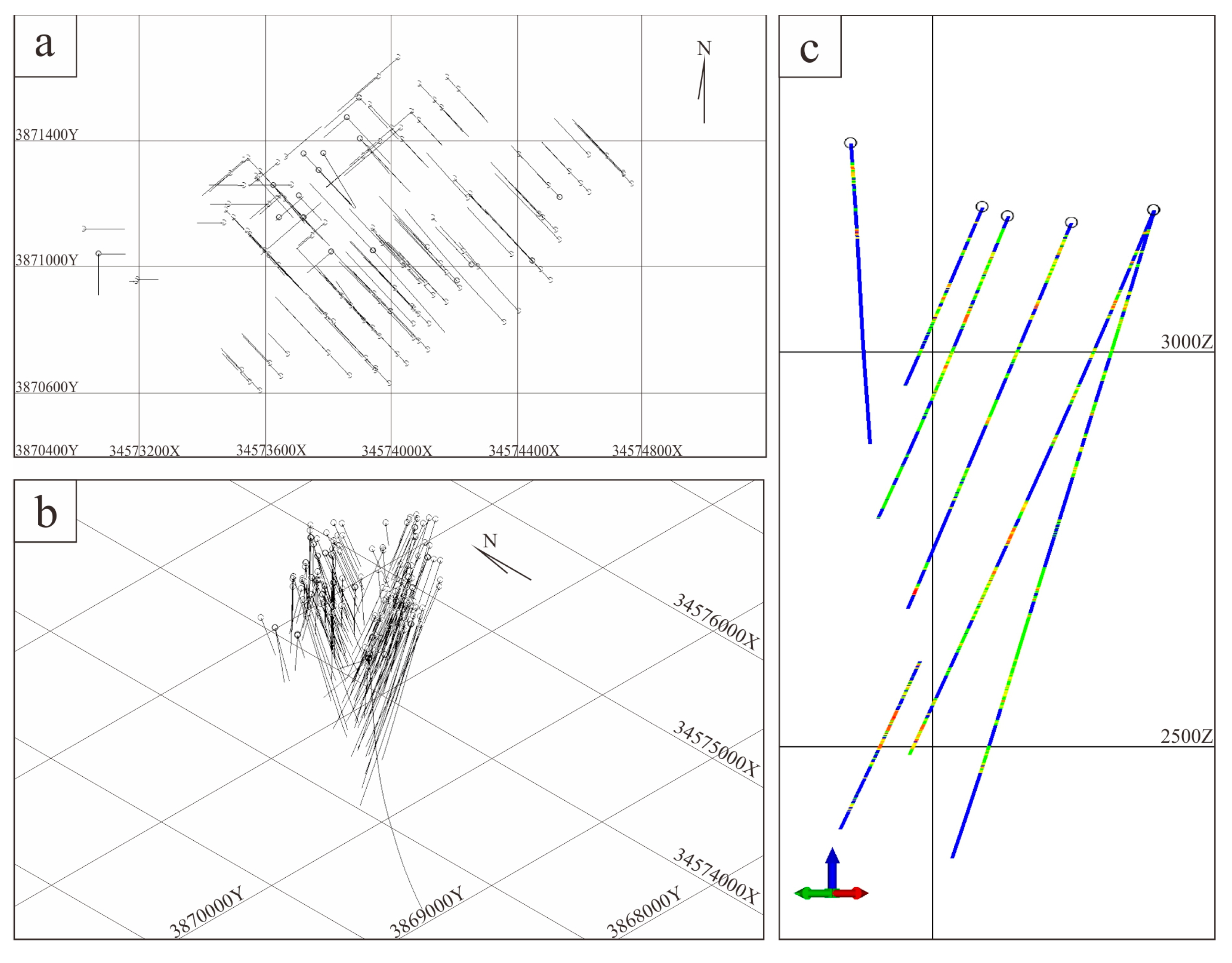
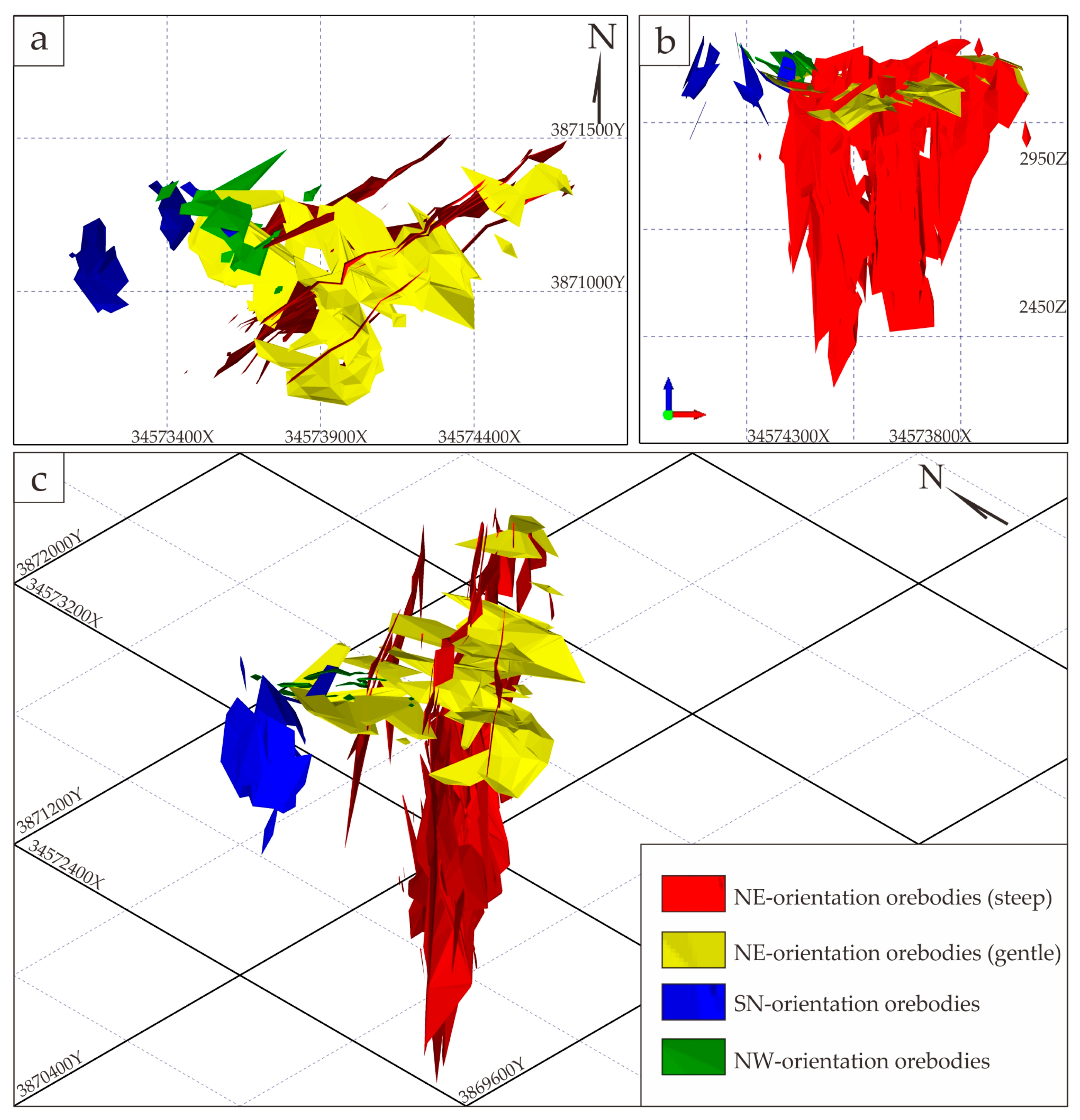
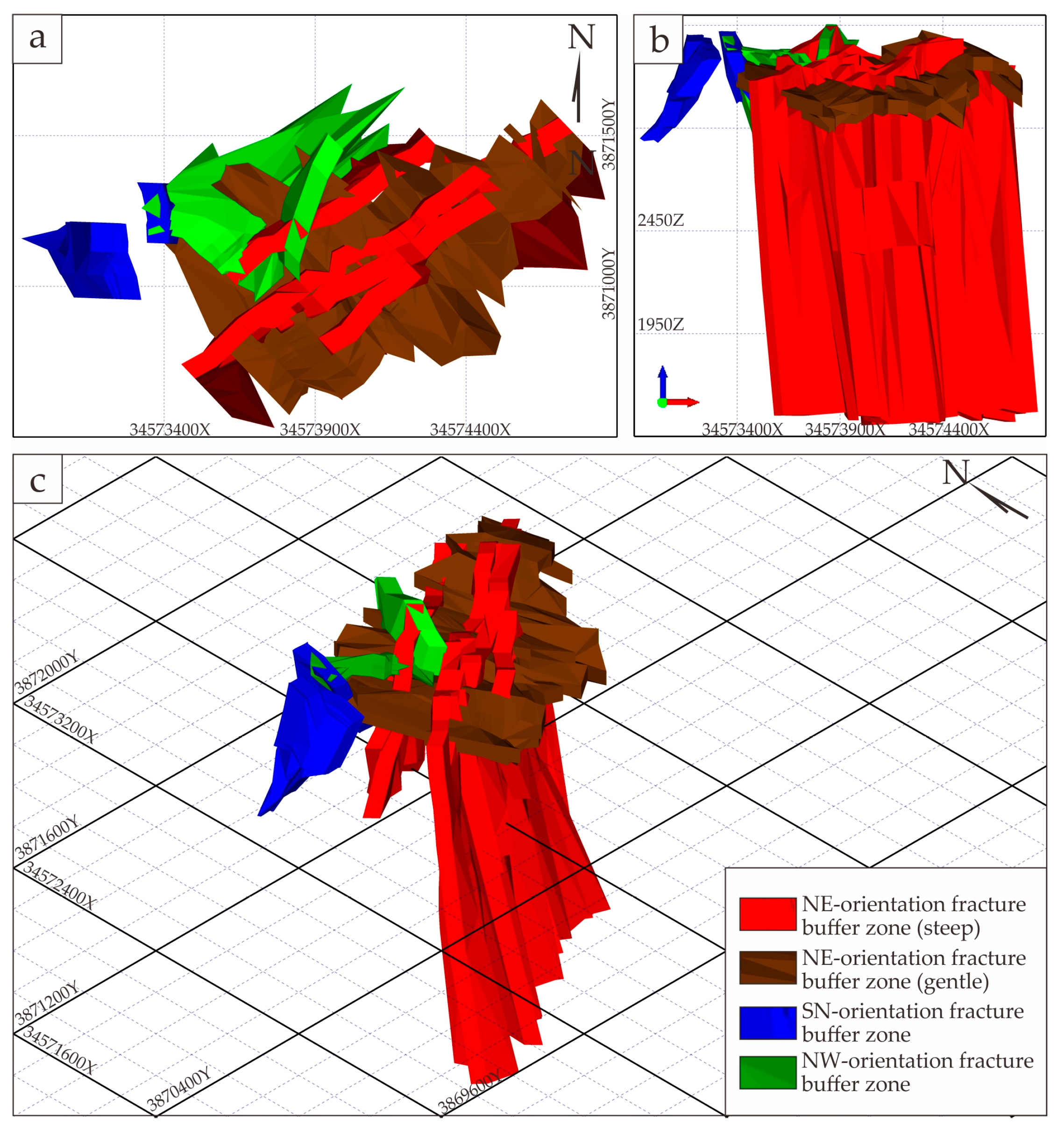

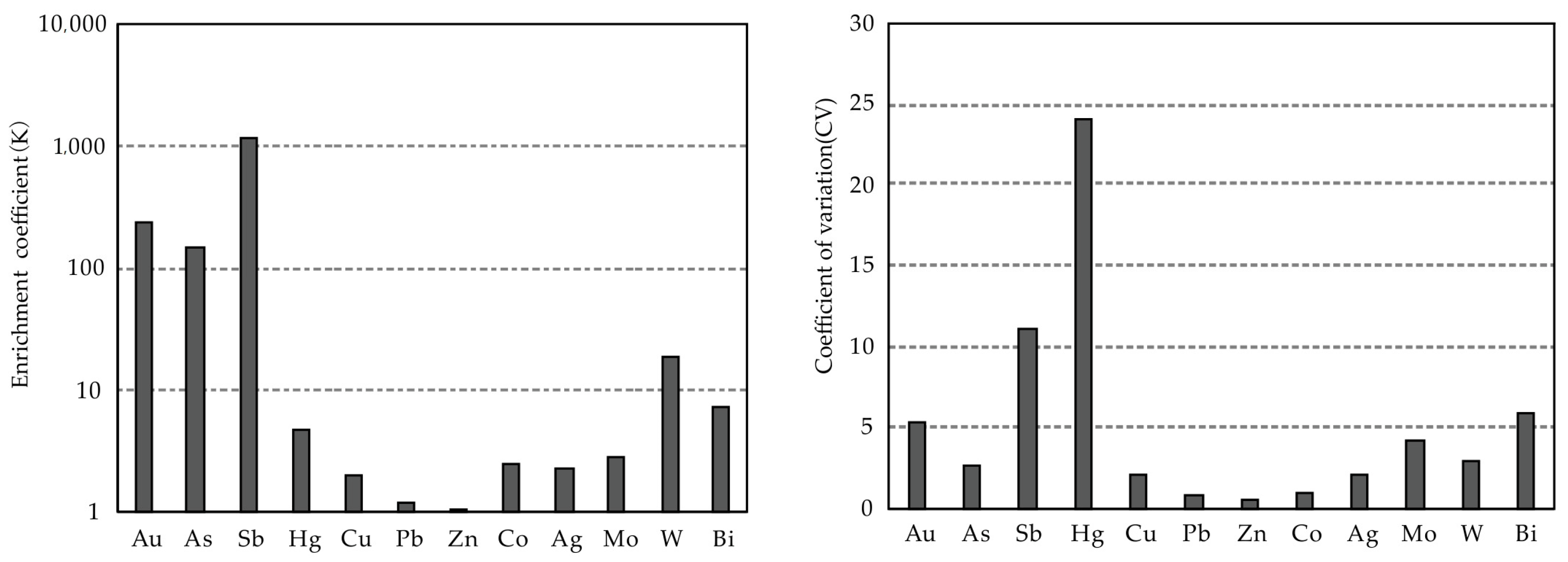
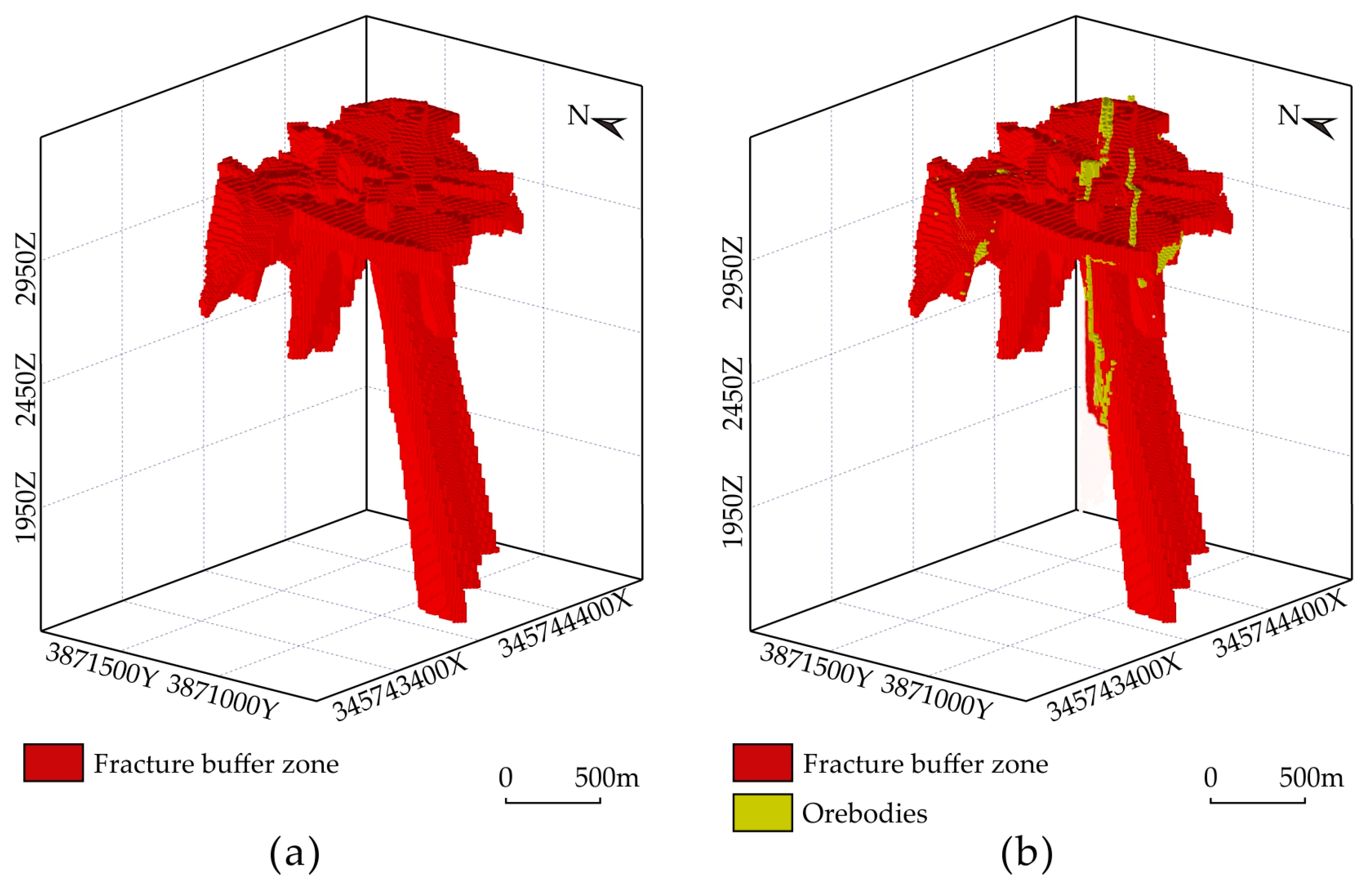
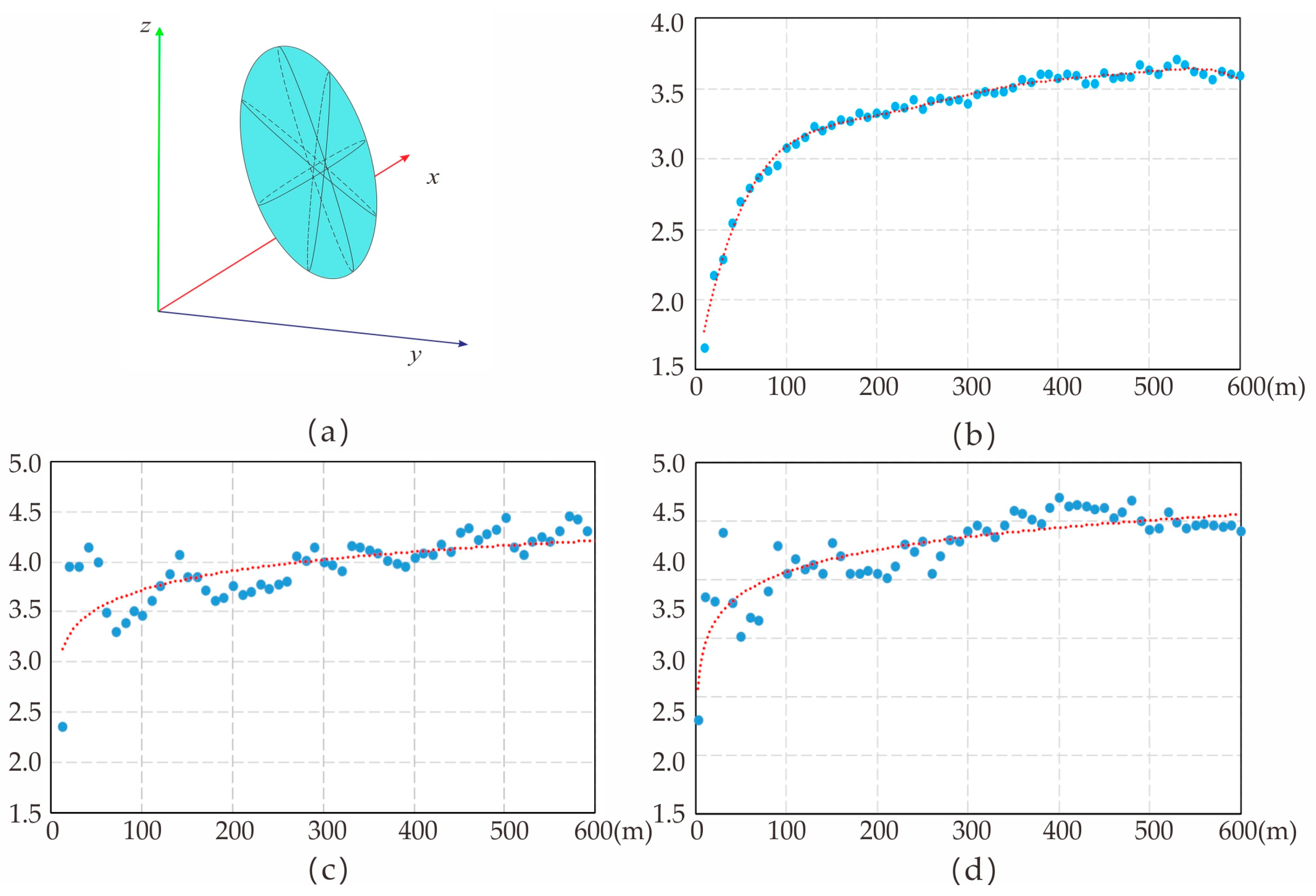



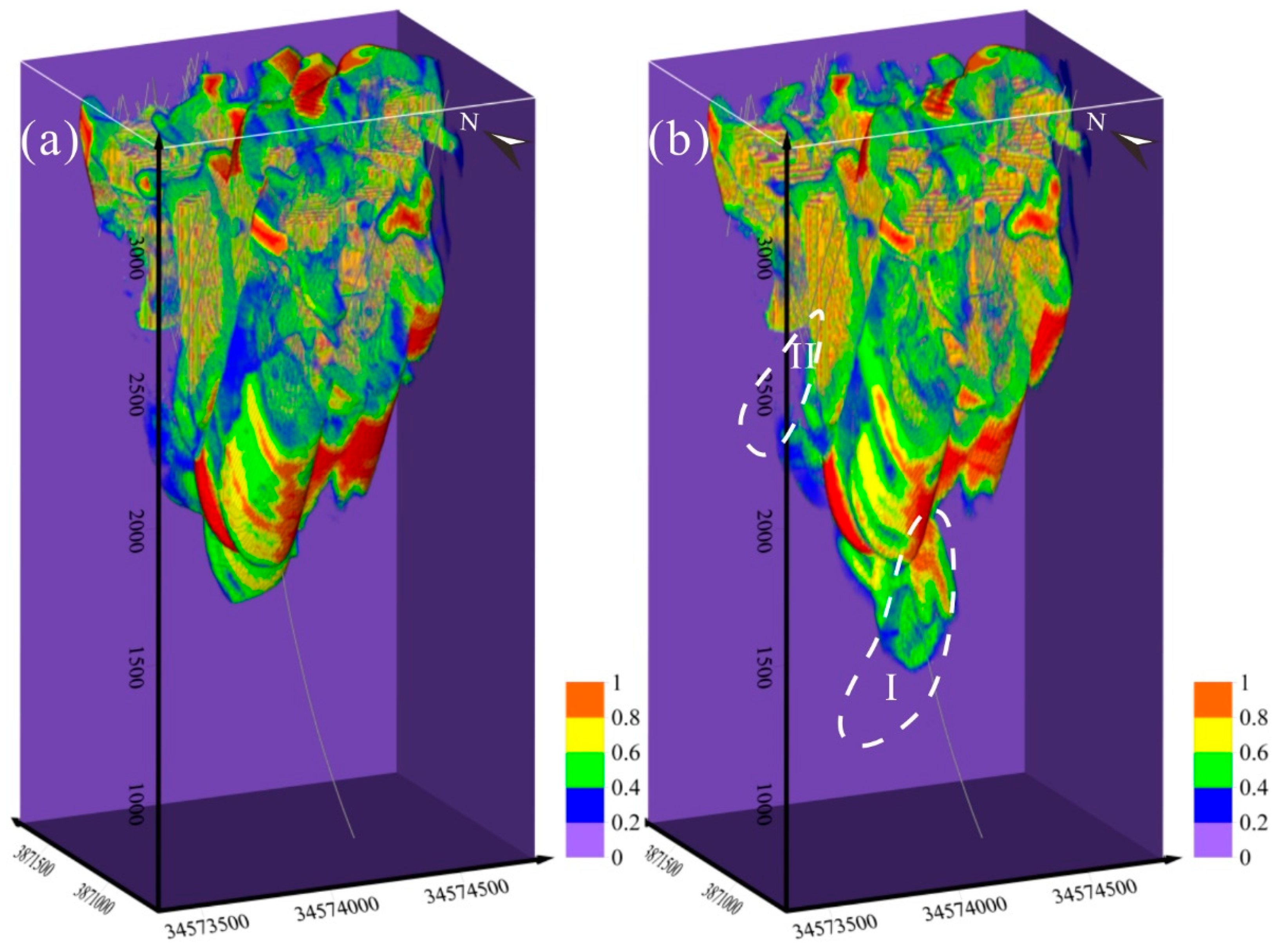
| Ore Block | Orientation | Fracture | Orebody |
|---|---|---|---|
| Eastern ore block | NE | F19~F27 | Au1, Au9, Au10, Au15, Au45, Au46, Au16, Au17, Au21, Au37, Au52, Au55 |
| NWW | F3 | M6, M4 | |
| Western ore block | NW | F42, F41, F34 | Au14 |
| N–S | F13~F11, F9~F8 | Au29, Au31 |
| Category | Description |
|---|---|
| Geological map | Topographic-geological map with the scale of 1:2000 |
| Horizontal section map | Horizontal section maps of elevations of 2450 m, 2530 m, 3610 m, 2850 m, 3010 m, 3050 m, 3090 m, and 3170 m |
| Geological profile | NE-orientation geological profiles of exploration lines of 54#, 58#, 62#, 66#, 70#, 74#, 78#, 81#, 89#, 93#, 96#, 98#, 100#, 102#, 106#, 110#, 114#, 118#, 120#, 128# |
| NW-orientation geological profiles of exploration lines of 192#, 196#, 199#, 200#, 202#, 204#, 208#, 212#, 216# | |
| N–S-orientation geological profiles of exploration lines of 283#, 287#, 291#, 292#, 295#, 298#, 302# | |
| Drilling log | 72 drillings |
| Geochemical data | 5028 samples; 12 elements of Ag, As, Au, Cu, Hg, Pb, Zn, Sb, W, Bi, Co, and Mo |
| Element | Minimum | Mean | Median | Maximum | Standard Deviation | Anomaly Threshold | K | CV |
|---|---|---|---|---|---|---|---|---|
| Au | 0.15 | 202.53 | 11 | 35,300 | 1064.67 | 2331.87 | 238.27 | 5.26 |
| As | 0.5 | 639.1 | 95.6 | 25,140 | 1677.3 | 3993.6 | 145.25 | 2.62 |
| Sb | 0.05 | 391.12 | 21.4 | 130,300 | 4329.22 | 9049.57 | 1150.35 | 11.07 |
| Hg | 0 | 58 | 23 | 94,931 | 1397 | 2852 | 4.86 | 23.96 |
| Cu | 0.5 | 34.1 | 28.6 | 3418 | 67.4 | 168.8 | 2 | 1.98 |
| Pb | 0.8 | 22.8 | 20.3 | 381.8 | 16.6 | 56.1 | 1.2 | 0.73 |
| Zn | 1.9 | 71.3 | 74.1 | 317 | 34.8 | 140.8 | 1.05 | 0.49 |
| Co | 0.1 | 24.5 | 17.5 | 142.6 | 22.5 | 69.5 | 2.45 | 0.92 |
| Ag | 0.007 | 0.136 | 0.088 | 9.795 | 0.272 | 0.68 | 2.27 | 2 |
| Mo | 0.01 | 1.75 | 0.44 | 304.05 | 7.3 | 16.34 | 2.82 | 4.18 |
| W | 0.05 | 17.75 | 7.5 | 1639.75 | 51.48 | 120.71 | 18.3 | 2.9 |
| Bi | 0 | 1.29 | 0.46 | 337.5 | 7.49 | 16.27 | 7.14 | 5.83 |
| Orientation | Lag (m) | Angular Tolerance | Number of Point Pairs | Nugget | Cumulative Sill | Range (m) |
|---|---|---|---|---|---|---|
| Main orientation | 10 | 22.5° | 60 | 1.65 | 1.89 | 230 |
| Secondary orientation | 10 | 22.5° | 60 | 2.26 | 1.87 | 220 |
| Vertical orientation | 10 | 22.5° | 60 | 2.12 | 1.88 | 110 |
| Element | Cumulative Frequency | ||||||||
|---|---|---|---|---|---|---|---|---|---|
| 5% | 15% | 25% | 40% | 60% | 75% | 85% | 95% | 100% | |
| ln(Au) | −0.11 | 0.69 | 1.19 | 1.93 | 3.00 | 4.22 | 5.27 | 6.89 | 11.24 |
| ln(As) | 2.23 | 2.91 | 3.38 | 4.04 | 5.14 | 6.07 | 6.91 | 8.09 | 10.13 |
| ln(Sb) | 0.26 | 1.17 | 1.80 | 2.57 | 3.43 | 4.07 | 4.66 | 6.02 | 11.78 |
| ln(Hg) | 2.18 | 2.53 | 2.73 | 2.97 | 3.29 | 3.61 | 3.94 | 4.63 | 11.46 |
| ln(Cu) | 2.08 | 2.54 | 2.86 | 3.21 | 3.49 | 3.67 | 3.86 | 4.28 | 8.14 |
| ln(Pb) | 2.01 | 2.51 | 2.73 | 2.91 | 3.10 | 3.25 | 3.38 | 3.74 | 5.94 |
| ln(Zn) | 2.69 | 3.33 | 3.94 | 4.20 | 4.45 | 4.57 | 4.65 | 4.77 | 5.76 |
| ln(Co) | 2.07 | 2.32 | 2.53 | 2.75 | 2.91 | 3.03 | 3.35 | 4.42 | 4.96 |
| ln(Ag) | −2.92 | −2.76 | −2.66 | −2.54 | −2.33 | −2.12 | −1.97 | −1.05 | 2.28 |
| ln(Mo) | −1.61 | −1.61 | −1.61 | −1.11 | −0.56 | 0.00 | 0.69 | 1.89 | 5.72 |
| ln(W) | 0.41 | 0.83 | 1.12 | 1.59 | 2.29 | 2.83 | 3.26 | 4.03 | 7.40 |
| ln(Bi) | −2.18 | −1.54 | −1.22 | −0.92 | −0.63 | −0.26 | 0.19 | 1.20 | 5.82 |
| Predictive Factors | Description of Variables | Variables | |
|---|---|---|---|
| Geology | Magmatic rocks | Concealed intermediate acidic intrusion, quartz diorite (porphyrite), high potassium calcium alkaline series | The three-dimensional model of quartz diorite porphyrite |
| Structures | Fault surface and fracture surface; lithologic interface | The 30 m structural buffer zone model | |
| Geochemistry | Element Combinations | Au, As, and Sb combination; Au content is above 15 × 10−9, Sb content is above 30 × 10−6, which are direct geochemical indicators for gold exploration | Au, As, and Sb |
| Primary Halo | As-Sb-Hg (front halo) → Au-Ag-Cu-Pb-Zn (near-ore halo) → W-Bi-Co-Mo (tail halo) | Au-Ag-Cu-Pb-Zn (As-Sb-Hg)/(W-Bi-Co-Mo) |
| Architecture | Feature Maps | Kernel Size | Strides | Padding | Channels |
|---|---|---|---|---|---|
| Input | 9, 9, 9 | 7 | |||
| Conv_1 | 5, 5, 5 | 3, 3, 3 | 2, 2, 2 | same | 14 |
| Conv_2 | 5, 5, 5 | 3, 3, 3 | 2, 2, 2 | same | 21 |
| TConv_1 | 5, 5, 5 | 3, 3, 3 | 1, 1, 1 | valid | 14 |
| TConv_2 | 9, 9, 9 | 3, 3, 3 | 2, 2, 2 | same | 7 |
| Output | 9, 9, 9 | 3, 3, 3 | 1, 1, 1 | same | 1 |
Disclaimer/Publisher’s Note: The statements, opinions and data contained in all publications are solely those of the individual author(s) and contributor(s) and not of MDPI and/or the editor(s). MDPI and/or the editor(s) disclaim responsibility for any injury to people or property resulting from any ideas, methods, instructions or products referred to in the content. |
© 2023 by the authors. Licensee MDPI, Basel, Switzerland. This article is an open access article distributed under the terms and conditions of the Creative Commons Attribution (CC BY) license (https://creativecommons.org/licenses/by/4.0/).
Share and Cite
Li, C.; Liu, B.; Xiao, K.; Kong, Y.; Wang, L.; Tang, R.; Xie, M.; Wu, Y. Metallogenic Prediction of the Zaozigou Gold Deposit Using 3D Geological and Geochemical Modeling. Minerals 2023, 13, 1205. https://doi.org/10.3390/min13091205
Li C, Liu B, Xiao K, Kong Y, Wang L, Tang R, Xie M, Wu Y. Metallogenic Prediction of the Zaozigou Gold Deposit Using 3D Geological and Geochemical Modeling. Minerals. 2023; 13(9):1205. https://doi.org/10.3390/min13091205
Chicago/Turabian StyleLi, Cheng, Bingli Liu, Keyan Xiao, Yunhui Kong, Lu Wang, Rui Tang, Miao Xie, and Yixiao Wu. 2023. "Metallogenic Prediction of the Zaozigou Gold Deposit Using 3D Geological and Geochemical Modeling" Minerals 13, no. 9: 1205. https://doi.org/10.3390/min13091205




